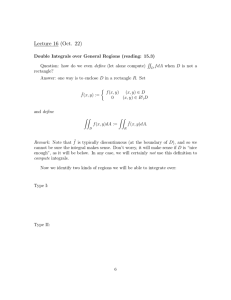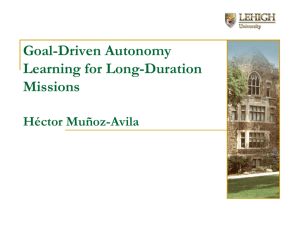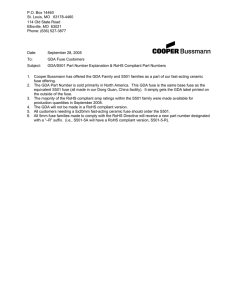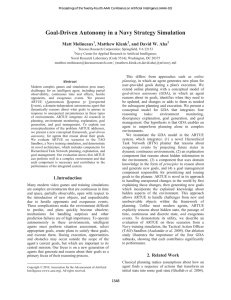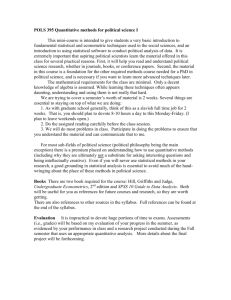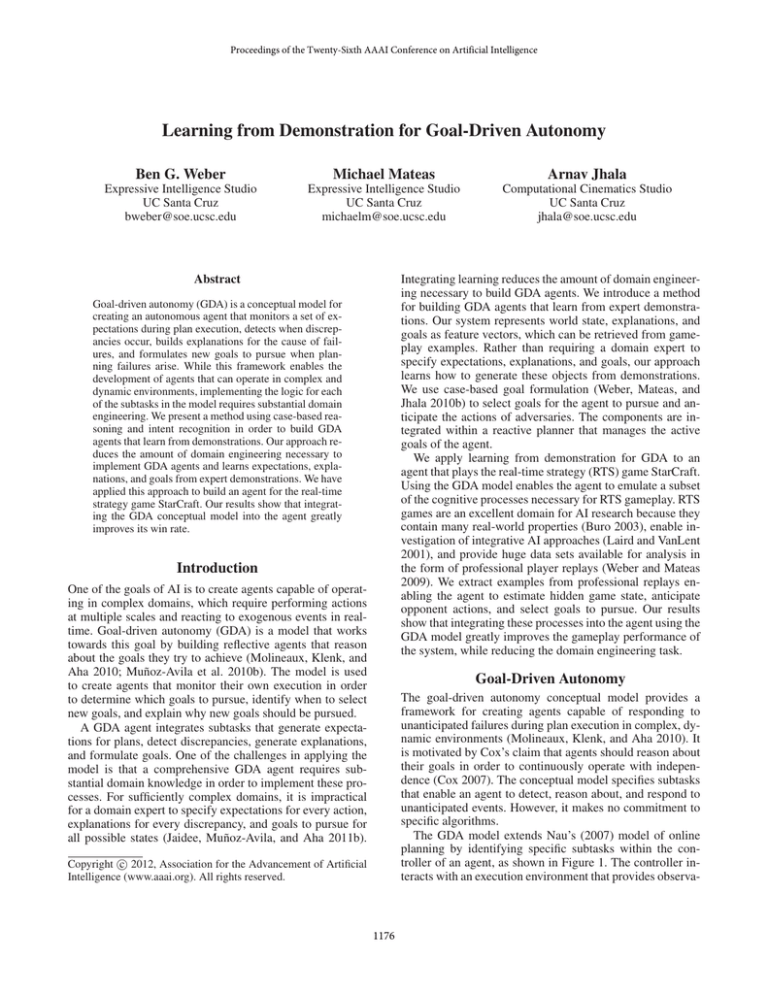
Proceedings of the Twenty-Sixth AAAI Conference on Artificial Intelligence
Learning from Demonstration for Goal-Driven Autonomy
Ben G. Weber
Michael Mateas
Arnav Jhala
Expressive Intelligence Studio
UC Santa Cruz
bweber@soe.ucsc.edu
Expressive Intelligence Studio
UC Santa Cruz
michaelm@soe.ucsc.edu
Computational Cinematics Studio
UC Santa Cruz
jhala@soe.ucsc.edu
Abstract
Integrating learning reduces the amount of domain engineering necessary to build GDA agents. We introduce a method
for building GDA agents that learn from expert demonstrations. Our system represents world state, explanations, and
goals as feature vectors, which can be retrieved from gameplay examples. Rather than requiring a domain expert to
specify expectations, explanations, and goals, our approach
learns how to generate these objects from demonstrations.
We use case-based goal formulation (Weber, Mateas, and
Jhala 2010b) to select goals for the agent to pursue and anticipate the actions of adversaries. The components are integrated within a reactive planner that manages the active
goals of the agent.
We apply learning from demonstration for GDA to an
agent that plays the real-time strategy (RTS) game StarCraft.
Using the GDA model enables the agent to emulate a subset
of the cognitive processes necessary for RTS gameplay. RTS
games are an excellent domain for AI research because they
contain many real-world properties (Buro 2003), enable investigation of integrative AI approaches (Laird and VanLent
2001), and provide huge data sets available for analysis in
the form of professional player replays (Weber and Mateas
2009). We extract examples from professional replays enabling the agent to estimate hidden game state, anticipate
opponent actions, and select goals to pursue. Our results
show that integrating these processes into the agent using the
GDA model greatly improves the gameplay performance of
the system, while reducing the domain engineering task.
Goal-driven autonomy (GDA) is a conceptual model for
creating an autonomous agent that monitors a set of expectations during plan execution, detects when discrepancies occur, builds explanations for the cause of failures, and formulates new goals to pursue when planning failures arise. While this framework enables the
development of agents that can operate in complex and
dynamic environments, implementing the logic for each
of the subtasks in the model requires substantial domain
engineering. We present a method using case-based reasoning and intent recognition in order to build GDA
agents that learn from demonstrations. Our approach reduces the amount of domain engineering necessary to
implement GDA agents and learns expectations, explanations, and goals from expert demonstrations. We have
applied this approach to build an agent for the real-time
strategy game StarCraft. Our results show that integrating the GDA conceptual model into the agent greatly
improves its win rate.
Introduction
One of the goals of AI is to create agents capable of operating in complex domains, which require performing actions
at multiple scales and reacting to exogenous events in realtime. Goal-driven autonomy (GDA) is a model that works
towards this goal by building reflective agents that reason
about the goals they try to achieve (Molineaux, Klenk, and
Aha 2010; Muñoz-Avila et al. 2010b). The model is used
to create agents that monitor their own execution in order
to determine which goals to pursue, identify when to select
new goals, and explain why new goals should be pursued.
A GDA agent integrates subtasks that generate expectations for plans, detect discrepancies, generate explanations,
and formulate goals. One of the challenges in applying the
model is that a comprehensive GDA agent requires substantial domain knowledge in order to implement these processes. For sufficiently complex domains, it is impractical
for a domain expert to specify expectations for every action,
explanations for every discrepancy, and goals to pursue for
all possible states (Jaidee, Muñoz-Avila, and Aha 2011b).
Goal-Driven Autonomy
The goal-driven autonomy conceptual model provides a
framework for creating agents capable of responding to
unanticipated failures during plan execution in complex, dynamic environments (Molineaux, Klenk, and Aha 2010). It
is motivated by Cox’s claim that agents should reason about
their goals in order to continuously operate with independence (Cox 2007). The conceptual model specifies subtasks
that enable an agent to detect, reason about, and respond to
unanticipated events. However, it makes no commitment to
specific algorithms.
The GDA model extends Nau’s (2007) model of online
planning by identifying specific subtasks within the controller of an agent, as shown in Figure 1. The controller interacts with an execution environment that provides observa-
c 2012, Association for the Advancement of Artificial
Copyright Intelligence (www.aaai.org). All rights reserved.
1176
use case-based reasoning to predict expected states and formulate goals in response to discrepancies. Our approach
generates expectations, explanations and goals as well, but
learns a case library by directly capturing examples from
professional demonstrations rather than online learning. Another difference in our approach is that intent recognition is
used to generate explanations of future world state rather
than generating explanations of the current world state.
Previous work on goal-driven autonomy has explored
case-based reasoning for learning explanations and goals.
Jaidee et al. (2011b) used reinforcement learning to automatically acquire goal selection knowledge, but showed that
the learned model was less effective than an expert-specified
model. In this approach the case library is defined manually
and the system learns expected states and values for goals
online. This differs from our approach that populates a case
library by extracting examples from gameplay demonstrations in order to reduce the domain engineering task.
Case-Based Goal Formulation
Case-based goal formulation is a method for performing
goal formulation using a collection of demonstrations (Weber, Mateas, and Jhala 2010b). It is similar to sequential
instance-based learning (Epstein and Shih 1998), but selects
goals rather than actions. We use case-based goal formulation to select goals for an agent to pursue and to model the
actions of opponents in adversarial domains. It is defined as
follows:
The agent’s goal state, g, is a vector computed by retrieving the most similar case, q, to the world state, s,
and adding the difference between q and its future state,
q0, which is the state after n actions have been applied
to q.
Formally:
Figure 1: A GDA agent interacts with a planner and execution environment and incorporates a controller with subtasks
for monitoring plan execution.
tions of world state and a planner that generates sequences
of actions to achieve the agent’s current active goal. In order to identify when planning failures occur, a GDA agent
requires the planning component to generate an expectation
of world state after executing each action in the execution
environment.
A GDA agent starts by passing an initial goal to the planner. The planner generates a plan consisting of a set of actions, a, and expectations, p. As actions are performed in
the execution environment, the discrepancy detector checks
if the resulting world state, s, matches the expected world
state. When a discrepancy is detected between the expected
and actual world states, the agent creates a discrepancy, d,
which is passed to the explanation generator. Given a discrepancy, the explanation generator builds an explanation,
e, of why the failure occurred and passes it to the goal formulator. The goal formulator takes an explanation and formulates a goal, g, in response to the explanation. The goal
is then passed to the goal manager, which is responsible for
selecting the agent’s active goal.
The model has been used to build autonomous agents
for naval strategy simulations (Molineaux, Klenk, and Aha
2010), first-person shooters (Muñoz-Avila et al. 2010b;
Muñoz-Avila and Aha 2010), and real-time strategy games
(Jaidee, Muñoz-Avila, and Aha 2011a). In previous work
we applied the GDA model to StarCraft, and hand-authored
rules for generating expectations, explanations, and goals
(Weber, Mateas, and Jhala 2010a). These approaches require
a domain expert to specify expectations for every action,
explanations for every discrepancy, and goals for every explanation. To reduce the amount of domain engineering required to author GDA agents, Muñoz-Avila et al. (2010a)
q = argmin distance(s, c)
c∈L
g = s + (q0 − q)
where g is a numerical vector representing the goal state, c
is a case in the case library, L, and the distance function may
be a domain independent or domain specific distance metric.
We refer to the number of actions, n, needed to achieve the
generated goal state as the planning window size.
Trace Algorithm
The Trace algorithm implements case-based goal formulation using traces of world state. A trace is a list of tuples
containing world state and actions, and is a single episode
demonstrating how to perform a task in a domain. For example, a game replay is a trace that contains the current game
state and player actions executed in each game frame.
The algorithm utilizes a case representation where each
case is a numerical feature vector that describes the goal
state at a specific time. The algorithm can determine the actions performed between different time steps by analyzing
the difference between feature vectors. Cases from a trace
are indexed using the time step feature. This enables efficient
lookup of q0 once a case, q, has been selected. Assuming that
1177
describing an adversarial object type, x, in the retrieved case,
q, which changes from a zero value to a positive value between time t and time t + m. The time selected for the expectation is the smallest time step, τ , where the feature has
a positive value.
the retrieved case occurred at time t in the trace, q0 is defined
by the world state at time t + n. Since the algorithm uses a
feature vector representation, g can be computed as follows:
g(x) = s(x) + (qt+n (x) − qt (x))
where x is a feature in the case representation.
Detecting Discrepancies
Learning GDA Subtasks
We define a discrepancy, d, as an expectation that is not met.
This situation occurs when an adversary does not perform
actions causing an anticipated state change. Our system creates a discrepancy when the following conditions are met:
We present an approach for learning expectations, explanations and goals for a GDA agent from demonstration. Our
approach focuses on adversarial domains, in which planning
failures or exogenous events occur due to the actions of other
agents. We use two case libraries: the adversary library, AL,
provides examples for adversary actions and is used for intent recognition by performing goal formulation on the adversary’s state, while the goal library, GL, is used to select
goals for the agent to pursue. By using case-based goal formulation to retrieve goals from the adversarial case library,
we can build predictions of the future actions of an adversary. We refer to the number of actions, m, that our retrieval
mechanism looks ahead at the adversary’s actions as the adversary planning window.
Our approach utilizes a numerical feature vector representation to describe world state. The representation includes
features for describing the agent’s world state and a single
adversary’s world state. By performing actions in the execution environment, an agent can create or destroy objects
in the execution environment. A non-zero feature value describes the existence of a specific object type in the environment.
p(x, τ ), st (x) = 0, t ≥ τ + δ
where δ is a discrepancy period, which provides a buffer period for observing state changes. This situation occurs when
an object of type x has not been observed in the environment
before time τ +δ. Because StarCraft enforces partial observability through a fog-of-war, it is possible for our system to
incorrectly detect discrepancies due to insufficient vision of
the opponent state.
Generating Explanations
Our system generates explanations when the active goal
completes or a discrepancy is detected. It creates explanations by applying goal formulation to the adversary, using
the adversary case library. We define an explanation, e, as
a prediction of future world state resulting from the execution of an adversary’s actions. Our system uses explanations
to attempt to identify how the adversary will change world
state. This definition differs from previous work in GDA,
which uses explanations in order to identify why discrepancies occur using current world state (Molineaux, Klenk, and
Aha 2010). Both our approach and previous work use explanations as input to the goal formulation subtask. We use
case-based goal formulation to create explanations as follows:
Building Expectations
We define an expectation, p, as an anticipated change in a
single world state feature caused by an adversary’s actions.
Each expectation represents an anticipated change in a single adversarial feature at a specific time. Specifically, expectations are beliefs that the adversary will perform an action
that introduces a new object type, x into the execution environment at a specific time, τ :
q = argmin distance(s, c)
c∈AL
e = s + (qt+m − qt )
p(x, τ ) : st (x) > 0, t ≥ τ
where AL is the adversary goal library, m is the number
of adversary actions to look ahead, and e is an anticipated
future world state. Our system uses explanations in order
to incorporate predictions about adversarial actions into the
goal formulation process.
where x is a feature that describes the adversary’s state.
When an expectation is generated, the agent anticipates the
presence of object type x in the execution environment after
time τ .
In order to build expectations, the system retrieves the
most similar case from the adversary case library and identifies times in which new objects are introduced into the environment. Our system triggers expectation generation when
a new active goal is selected by the goal manager. A set of
expectations, π, is generated as follows:
Formulating Goals
We define a goal, g, as a future world state for the agent to
achieve. The input to the goal formulation component is the
current world state and an explanation, e, which contains the
anticipated future world state of the adversary. Goal formulation is triggered when the agent’s active goal completes or
a discrepancy is detected. Our system formulates goals as
follows:
q = argmin distance(s, c)
c∈AL
π = {p(x, τ ) : τ = min[qv (x) > 0, v > t]
v
| ∀x, qt (x) = 0, qt+m (x) > 0}
q = argmin distance(e, c)
c∈GL
The retrieval process occurs at time t with a look-ahead window of size m. It generates an expectation for each feature
g = s + (qt+n − qt )
1178
where GL is the goal case library and the input to the case
retrieval similarity metric is an explanation of future world
state. The output of the formulation process is a goal that is
passed to the goal manager, which is responsible for selecting the agent’s active goal.
Table 1: An example trace showing when a player performed
build and train actions.
Frame Player Action
100
1
Train Worker
300
1
Build Depot
500
1
Train Worker
700
1
Build Barracks
900
1
Train Marine
Application to RTS Games
We applied goal-driven autonomy to build an agent for the
RTS game StarCraft1 . Real-time strategy games have manyreal world properties including partial observability and an
enormous decision complexity (Aha, Molineaux, and Ponsen 2005). StarCraft is an excellent domain for learning from
demonstration, because there are a huge number of professional replays available for analysis.
Our agent is an extension of McCoy and Mateas’ (2008)
integrated agent framework. It is implemented in the ABL
reactive planning language (Mateas and Stern 2002), which
is similar to BDI architectures such as PRS (Rao and
Georgeff 1995). We use ABL to implement goal management, because it provides mechanisms for supporting realtime plan execution and monitoring. Our system decomposes StarCraft gameplay into subproblems, and includes
managers for handling each of these tasks. These subproblems include strategy selection, production, income management, tactics and reconnaissance. We use GDA to implement
the strategy manager in the agent, which is responsible for
selecting the agent’s high-level strategy. The strategy manager selects which units to produce, structures to construct,
and upgrades to research.
One of our goals in using the GDA model is to emulate a
subset of the cognitive processes necessary for RTS gameplay (Weber, Mateas, and Jhala 2011). In StarCraft, players take the role of a commander in a military scenario and
are given the objective of destroying all opponents. Performing well in StarCraft requires building anticipations of opponent actions, formulating plans to counter opponents, scouting the map in order uncover opponent state, and selecting a
new strategy when the current strategy is no longer effective.
Many of these processes map to subtasks in the GDA model.
value of a new case is initially set to the value of the previous case, then the feature corresponding to the train or build
action is incremented by one. Considering a subset of the
features (# Workers, # Depots, # Barracks, # Marines), the
example trace would produce the following cases:
q1
q2
q3
q4
q5
q6
=< 4, 0, 0, 0 >
=< 5, 0, 0, 0 >
=< 5, 1, 0, 0 >
=< 6, 1, 0, 0 >
=< 6, 1, 1, 0 >
=< 6, 1, 1, 1 >
The case library consists of 1,831 traces and 244,459 cases.
Our approach differs from previous work, because cases are
extracted from gameplay traces rather than defined manually
(Muñoz-Avila et al. 2010a).
Our system uses the same case library contents for both
the adversary case library, AL, and the goal library, GL.
When retrieving cases using the adversary case library, AL,
the distance function uses a subset of features, which describe adversary state. This feature subset is used by the
expectation builder and explanation generator. The system generates expectations for features that correspond to
changes in adversary state, and explanations of future state
are computed based on changes in adversary state. When retrieving cases using the goal library, GL, the complete feature set is used by the distance function. During goal retrieval, the system computes the goal state based on changes
in agent state, while ignoring adversary state.
Case Representation
Our case representation is a feature vector that tracks the
number of units and buildings that each player has produced.
For each player, there is a feature for each unit and building
type, and the value of each feature is the number of the type
that have been produced since the start of the game.
We collected thousands of professional-level replays from
community websites and converted them to our case representation. The professional replays are the source of our case
library. Replays were converted from Blizzard’s proprietary
binary format into text logs of game actions using a thirdparty tool. A subset of an example trace is shown in Table 1.
An initial case, q1 , is generated with all values set to zero,
except for the worker unit type. It is set to 4, because the
player begins with 4 worker units. A new case is generated
for each action that trains a unit or produces a building. The
Integrating GDA
Our agent starts a game by selecting an initial strategic goal,
known as the build order, which becomes the agent’s active goal. In our current implementation, the initial goal is
provided by a domain expert. The active goal is passed to
the goal manager, which is implemented in the ABL reactive planning language (Weber, Mateas, and Jhala 2010a).
The different components in the system communicate using the reactive planner’s working memory as a blackboard
(Hayes-Roth 1985). The reactive planner is responsible for
performing the actions in the game necessary to achieve
the goal state. Plans are generated by the Trace algorithm,
which retrieves actions directly from traces. Our approach
differs from previous GDA implementations, because the
same component is used for both goal formulation and plan
generation.
1
StarCraft and its expansion StarCraft: Brood War were developed by Blizzard EntertainmentTM .
1179
The agent invokes the GDA subtask upon completion of
the initial goal. During this process, the agent generates an
explanation of the opponent’s future game state and builds
expectations of anticipated unit and building types. For example, the agent may expect the opponent to construct a
Starport, and train a fleet of Valkyrie aircraft. This anticipated game state is passed to the goal formulator, which selects the next strategic goal for the agent to pursue. In this
example, the agent would retrieve similar game situations
in which air units are produced by the opponent and formulate a goal to counter air units. The retrieved goal state is
then passed to the goal manager, becoming the current active
goal, and the expectation of an opponent Starport is passed
to the discrepancy detector.
After formulating a new goal and set of expectations, the
agent enters a plan monitoring phase. During this process,
the agent executes actions to pursue the active goal and
checks for discrepancies. For example, if the agent observes
an opponent Starport, then the expectation is validated and
the agent continues to pursue its current goal. However, if
the agent does not observe an opponent Starport after a discrepancy period has expired, then the expectation becomes
invalid, triggering a discrepancy. Upon detecting a discrepancy or achieving the current goal, the agent invokes the explanation generation subtask.
There are three free parameters in our GDA implementation: the planning window size, n, specifies the size of
plans resulting from goal formulation, the adversarial window size, m, specifies how far to look-ahead at opponent
actions, and the discrepancy period, δ, specifies a buffer period for detecting discrepancies. In order to find suitable values for these parameters, we ran an ablation study in which
GDA subtasks are individually integrated into the agent. We
use a greedy search to select parameter values.
Table 2: Win rates from the goal formulation experiment
show that the agent performed best with a planning window
size of 15 actions.
Planning
Win
Window Size (n)
Ratio
0
0.73
1
0.79
5
0.88
10
0.85
15
0.91
20
0.88
• Formulator: A version of the agent that integrates the
goal formulation subtask, with no look ahead or discrepancy detection.
• Predictor: A version of the agent that incorporates explanation generation and goal formulation, but no discrepancy detection.
• GDA Agent: A version of the agent implementing the
complete GDA model.
We evaluated each version of the agent separately in order
to select suitable values for GDA parameters and then compared the overall gameplay performance of each agent configuration.
In each experiment, we selected a different initial goal
for the agent. We selected different initial goals in order to
demonstrate improvements in the gameplay performance of
the system using the GDA model. There are game situations
in which using the GDA model does not improve the gameplay performance of the system, because the outcome of the
game is determined before any of the GDA subtasks are
invoked. This situation can arise in StarCraft, because the
game enforces partial observability through the fog-of-war
and the agent’s initial goal may be dominated by the opponent’s initial goal. In StarCraft, losing a game based solely
on initial goal selection is referred to as a build-order loss.
To prevent the agent’s win rate from plateauing due to this
aspect of RTS gameplay, we evaluated a variety of initial
goals in our experiments. Because different initial goals are
assigned to the agent, the win ratios reported in each experiment should not be directly compared to win ratios in other
experiments. A direct comparison of the different agent configurations utilizing the same initial goal is presented in our
fourth experiment.
In the first experiment, we evaluated the formulator agent
with various planning window sizes. We also evaluated the
base agent, represented by the formulator agent with a planning window of size 0. Results from the experiment are
shown in Table 2. The agent performed best with a planning window of size 15. With smaller window sizes the
agent often retrieved duplicate production actions resulting
in wasted resources. With larger window sizes, goal formulation is performed less frequently.
The second experiment evaluated the predictor agent with
various look-ahead window sizes and a fixed planning win-
Evaluation
We evaluated our approach by integrating the GDA model
in an agent that plays complete games of StarCraft. The
GDA model was used for implementing the strategy manager, while the remaining managers in the agent remained
unchanged. We ran an ablation study to demonstrate the importance of each GDA subtask in the agent.
The system was tested against the built-in AI of StarCraft
and bots submitted to the AIIDE 2011 StarCraft AI Competition2 including Aiur, SPAR, Cromulent, Nova, and BTHAI.
The map pool consisted of six maps from the competition,
which support two to four players and encourage a variety of
play styles. For each trial in our experiments, we evaluated
our agent against all permutations of bots and maps, resulting in 48 games. We utilize win ratio as a metric of agent
performance.
Our ablation study evaluated four versions of the agent.
In each experiment, we introduced an additional subtask of
the GDA model into the agent. We evaluated the following
configurations of the system:
• Base Agent: A base version of the agent with a fixed strategy goal and no GDA subtasks.
2
http://www.StarCraftAICompetition.com
1180
Table 3: Results from the opponent prediction experiment
show that the agent had the highest win ratio when integrating a look-ahead window of 10 actions.
Look-Ahead
Window Size (m)
0
5
10
15
20
Table 5: The fourth experiment evaluated all of the agent
configurations using the same initial goal. The agent performed best when using the complete GDA model.
Win
Ratio
0.71
0.75
0.79
0.73
0.69
Agent
Base
Formulation
Prediction
GDA
Table 6: Our agent had varying success against individual
opponents in the fourth experiment. The base version performed worst, while the complete GDA agent improved in
performance versus three of the opponent agents.
Table 4: Win rates from the discrepancy detection experiment show that the agent performed best with a discrepancy
period of 30 seconds.
Discrepancy
Period (δ)
∞
60
30
15
Win
Ratio
0.73
0.77
0.81
0.92
Win
Ratio
0.81
0.83
0.92
0.81
Blizzard Protoss
Blizzard Terran
Blizzard Zerg
Aiur
SPAR
Cromulent
Nova
BTHAI
Overall
dow size of 15. We also evaluated the formulator agent, represented by the predictor agent with a look-ahead window
of size 0. Results from the experiment are shown in Table 3.
The agent performed best with a look-ahead window size of
10. Incorporating predictions helped the agent prepare for
opponent strategies. With smaller window sizes, the agent
was unable to anticipate opponent actions in time to develop counter strategies, while large window sizes resulted
in the agent employing counter strategies too early, resulting
in wasted resources.
In the third experiment, we evaluated the complete GDA
agent with various discrepancy period sizes, and planning
window and look-ahead windows of size 15 and 10. We also
evaluated the predictor agent, represented by the GDA agent
with a discrepancy period of ∞. Results from the experiment are shown in Table 4. The agent performed best with a
discrepancy period of 30 seconds. Discrepancy detection enabled the agent to respond to critical game situations, such
as formulating goals to build detector units in order to reveal
cloaked units. When using larger discrepancy periods, the
agent rarely detected discrepancies that trigger new goals,
while smaller discrepancy periods resulted in the same problems as small planning window sizes.
The fourth experiment evaluated the different configurations of the agent using the same initial goal, providing a
direct comparison of the different agent configurations. Results from the experiment are shown in Table 5. The results show that each additional GDA subtask integrated into
the agent improved the overall system performance and the
agent has the highest win ratio when utilizing the complete
GDA model.
The agent had varying success against each of the opponent agents. Win rates versus individual opponents during
Base
0.14
1.00
1.00
0.00
1.00
1.00
0.67
1.00
0.73
Form.
0.33
1.00
1.00
0.00
1.00
1.00
0.83
1.00
0.77
Pred.
0.50
1.00
1.00
0.00
1.00
1.00
1.00
1.00
0.81
GDA
0.83
1.00
1.00
0.50
1.00
1.00
1.00
1.00
0.92
the fourth experiment are shown in Table 6. Five of the opponents were dominated by our agent, and all ablations of
the system achieved 100% win rates versus these opponents.
Against these opponents, the GDA subtasks for anticipating
opponent actions and triggering goal formulation were not
necessary to win.
Against three of the opponents, incorporating additional
GDA subtasks improved the performance of our agent. The
largest win ratio margin occurred versus the Blizzard Protoss
AI. This opponent demonstrated the widest variety of strategies, and using the GDA model enabled our agent to effectively respond to most of the encountered situations. Nova
executes a strategy that required the agent to build detection
units, and incorporating explanation generation enabled our
agent to anticipate this situation. The most significant improvement was demonstrated versus Aiur with discrepancy
detection enabled. However, the results versus the Blizzard
Protoss AI show that each of the GDA subtasks improved
performance.
Conclusions and Future Work
The GDA conceptual model provides a framework for building autonomous agents capable of operating in complex environments while responding to planning failures and exogenous events (Molineaux, Klenk, and Aha 2010). One of the
main challenges in implementing the model is the substantial amount of domain engineering necessary to specify expectations for every action, explanations for every discrepancy, and goals for every explanation.
1181
Mateas, M., and Stern, A. 2002. A Behavior Language for
Story-Based Believable Agents. IEEE Intelligent Systems
17(4):39–47.
McCoy, J., and Mateas, M. 2008. An Integrated Agent
for Playing Real-Time Strategy Games. In Proceedings of
AAAI, 1313–1318. AAAI Press.
Molineaux, M.; Klenk, M.; and Aha, D. W. 2010. GoalDriven Autonomy in a Navy Strategy Simulation. In Proceedings of AAAI, 1548–1553. AAAI Press.
Muñoz-Avila, H., and Aha, D. W. 2010. A Case Study
of Goal-Driven Autonomy in Domination Games. In Proceedings of the AAAI Workshop on Goal-Directed Autonomy. AAAI Press.
Muñoz-Avila, H.; Aha, D. W.; Jaidee, U.; and Carter, E.
2010a. Goal-Driven Autonomy with Case-Based Reasoning. In Proceedings of ICCBR, 228–241.
Muñoz-Avila, H.; Aha, D. W.; Jaidee, U.; Klenk, M.; and
Molineaux, M. 2010b. Applying Goal Driven Autonomy to
a Team Shooter Game. In Proceedings of FLAIRS, 465–470.
AAAI Press.
Nau, D. S. 2007. Current Trends in Automated Planning. AI
magazine 28(4):43.
Rao, A., and Georgeff, M. 1995. BDI Agents: From Theory
to Practice. In Proceedings of ICMAS, 312–319.
Weber, B. G., and Mateas, M. 2009. A Data Mining Approach to Strategy Prediction. In Proceedings of the IEEE
Symposium on Computational Intelligence and Games, 140–
147. IEEE Press.
Weber, B. G.; Mateas, M.; and Jhala, A. 2010a. Applying Goal-Driven Autonomy to StarCraft. In Proceedings of
AIIDE, 101–106. AAAI Press.
Weber, B. G.; Mateas, M.; and Jhala, A. 2010b. Case-Based
Goal Formulation. In Proceedings of the AAAI Workshop on
Goal-Directed Autonomy. AAAI Press.
Weber, B. G.; Mateas, M.; and Jhala, A. 2011. Building
Human-Level AI for Real-Time Strategy Games. In Proceedings of the AAAI Fall Symposium on Advances in Cognitive Systems, 329–336. AAAI Press.
We presented an approach for learning GDA subtasks
from demonstration, reducing the authorial burden of creating GDA agents. Our system learns expectations, explanations, and goals from expert examples. We use case-based
goal formulation to predict changes in world state caused by
adversaries and to select goals for the agent to pursue. The
agent formulates new goals when the current active goal is
accomplished or a discrepancy is detected.
We used the GDA model to implement strategy selection
in an agent that plays complete games of StarCraft. Our ablation study showed that integrating additional GDA subtasks into the agent improved the win ratio of the agent,
and the system performed best when implementing the complete GDA model. Additionally, the GDA model provided
an interface for integrating case-based reasoning and reactive planning in a real-time agent.
In future work, we will evaluate the agent versus human
opponents. One of the limitations of our ablation study was
that it was restricted to a small sample of opponents. By incorporating humans into the evaluation process, we can test
the agent versus a much larger player base. This analysis
will enable evaluation of the agent while reducing the bias
of individual opponents.
Acknowledgments
This material is based upon work supported by the National
Science Foundation under Grant Number IIS-1018954. Any
opinions, findings, and conclusions or recommendations expressed in this material are those of the authors and do not
necessarily reflect the views of the National Science Foundation.
References
Aha, D. W.; Molineaux, M.; and Ponsen, M. 2005. Learning
to Win: Case-Based Plan Selection in a Real-Time Strategy
Game. In Proceedings of ICCBR, 5–20. Springer.
Buro, M. 2003. Real-Time Strategy Games: A New AI
Research Challenge. In Proceedings of IJCAI, 1534–1535.
Cox, M. 2007. Perpetual Self-Aware Cognitive Agents. AI
Magazine 28(1):32–45.
Epstein, S., and Shih, J. 1998. Sequential Instance-Based
Learning. In Mercer, R., and Neufeld, E., eds., Lecture Notes
in Computer Science, volume 1418. Springer. 442–454.
Hayes-Roth, B. 1985. A Blackboard Architecture for Control. Artificial Intelligence 26(3):251–321.
Jaidee, U.; Muñoz-Avila, H.; and Aha, D. W. 2011a. CaseBased Learning in Goal-Driven Autonomy Agents for RealTime Strategy Combat Tasks. In Proceedings of the ICCBR
Workshop on Computer Games, 43–52.
Jaidee, U.; Muñoz-Avila, H.; and Aha, D. W. 2011b. Integrated Learning for Goal-Driven Autonomy. In Proceedings
of IJCAI, 2450–2455.
Laird, J., and VanLent, M. 2001. Human-Level AI’s Killer
Application: Interactive Computer Games. AI magazine
22(2):15–25.
1182

